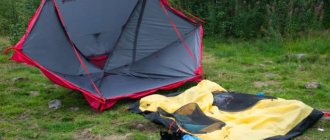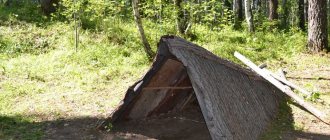The Rescue Blanket, also known as the Space Blanket, Mylar Blanket, Thermal Blanket, and Emergency Bag, was developed for NASA in 1964. In the USA it went on sale almost the same year it was manufactured and was very well appreciated by local survivalists.
In Russia, the rescue blanket became widely available only after 2000.
The technology for manufacturing a space rescue suit is very simple - it is a thin plastic film (PET plastics are mainly used) with a metallized coating.
As a result of this symbiosis, the thermal blanket material was able to reflect up to 97% of the heat emitted by the wrapped object. In addition, the film is waterproof and allows you to use the space thermal blanket as a raincoat. If you wrap such a blanket around your body, it will prevent the development of hypothermia and frostbite in cold and frosty weather.
The downside of a space blanket is its increased rustling, so you shouldn’t sleep wrapped in such a space blanket in a group; they can even be kicked out of the tent for excessive noise that occurs at the slightest movement.
The second advantage of a rescue thermal blanket is its compactness and low price. This allows you to put a package with a rescue blanket in the NAZ without thinking about its dimensions and weight.
How to use a rescue blanket
I most often use the life blanket incorrectly.
This rescue blanket has good heat-reflecting properties, but at the same time it also has good thermal conductivity.
For example, if you lay a rescue blanket on a rock and lie down on top of it, you will still feel the coldness of the rock.
But if you sit on a log, with your clothes on, and wrapped in a safety blanket, it will reflect the infrared radiation back and you will be much warmer.
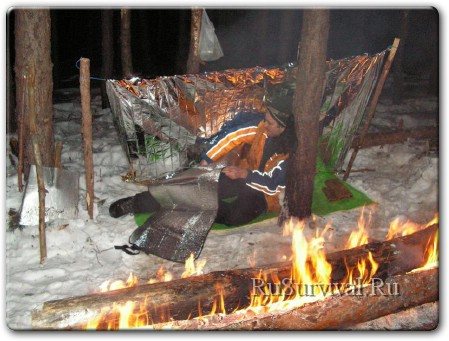
On hikes, a rescue blanket is most often used to create a screen that reflects heat on tourists sleeping in sleeping bags.
In addition, a rescue thermal blanket can be used as a signal device; due to its high reflectivity, a rescue blanket laid out on the ground will be clearly visible from the air, and stretched between two branches – from afar and on the ground.
Since the rescue blanket is waterproof, it can be used to make a small tent.
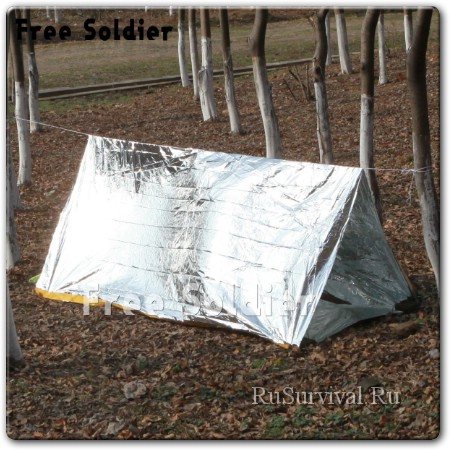
It is enough to stretch a rope between two trees or driven pegs and cover it with a rescue thermal blanket, we get protection from the rain, and by fixing the edges of the thermal blanket, we get a simple tent.
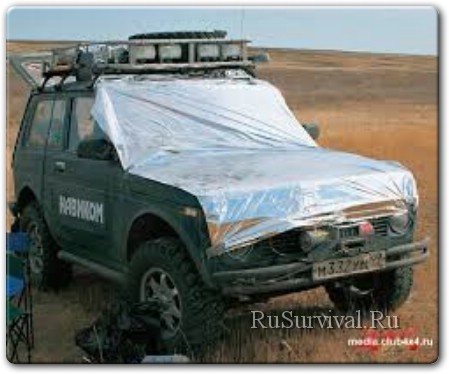
A rescue blanket can also be used to protect a car from overheating by the sun's rays.
In this case, the shiny surface simply reflects the light flux from the sun and the car heats up much less.
You can wrap food in a rescue blanket and it will maintain its temperature - hot things will stay hot, and cold things will stay cold. You just need to take into account that there should be a layer of air between the layers of the blanket, then an improvised thermos will work much better.
Rescue blanket and 10 ways to use it

The space blanket, also known as the mylar, thermal or escape blanket, was developed for NASA in 1964.
It is made from a thin plastic film, mainly PET, with a metal coating. Typically, such thermal blankets have a golden or silver color. The thermal blanket material is capable of reflecting up to 97% of the heat emitted by the object that is wrapped in it. The material of this blanket is also waterproof. These properties of a thermal blanket can play a key role in saving a person’s life, especially if it’s cold. If you wrap such a blanket around your body, it will prevent the development of hypothermia and frostbite in cold and frosty weather. It can also work as a raincoat in rainy weather.
In addition, most rescue blankets that are on sale are “space” blankets, and are designed for use in all weather conditions. They are not disposable and are quite durable. Also, some models of such blankets have eyelets along the edges and can be used as an awning for making a shelter, to protect equipment from moisture, or as a bedding if the ground is cold or wet.
If your equipment includes not one, but several thermal blankets, you can make a small tent from them (like from awnings). Also, do not forget about the waterproof properties of such a blanket, which allows you to use it as a raincoat.
But now let’s talk about non-obvious ways to use a “space” blanket.
The content of the article
1. Making fire
As shown in one of the TV shows about survivalists (Fat Guys In The Woods (Season 2, Episode 1″Operation Desert Patrol), parts of the space blanket can be shaped into a concave shape and used to concentrate the sun's rays, which will ignite kindling for a fire. Although this is a fairly time-consuming method of making fire, it works, or you can simplify the system and simply use any bowl or even a hole in the ground to concentrate a beam of sunlight on the kindling and light it.
To do this, you need to line the selected container or hole with flat edges with a thermal blanket, the reflective side out. Moreover, do this in such a way that there is a beam of light in its center, and the walls of the concavity are used as a reflector (as in flashlights). After this, exactly in the place where the rays of light are concentrated, you need to place the kindling on some kind of dense stand (so that the blanket does not deteriorate) and wait until the kindling begins to smolder.
Cooking and water purification
Using the method described above - using a bowl or a hole in the ground covered with a thermal blanket, you can create a kind of oven in which you can try cooking food or heating a small volume of water using concentrated sunlight. To heat water, you will need a clean metal or plastic container, such as a mug.
Ultraviolet rays and temperature, when heated by a concentrated beam of sunlight, will clear the water of most harmful bacteria and parasites in an average of 6 hours.
Giardia, Cryptosporidium, Salmonella typhi, and E. coli, for example, are killed at 140° F (60° C), and Hepatitis A is killed at 149° F (65° C), but for this to happen, it must be exposed to this temperature for a long time, and since you most likely will not have the opportunity to measure the heating temperature of the water, let it stand in the sun for as long as possible.
Signaling means
Using a thermal blanket, you can create a signal mirror or hang it as a marker for search groups so that it can be seen from the air.
For ease of use and carrying, it can be attached to a branch, piece of plastic or wood.
4. Rope
The material of a rescue blanket is quite durable, and if you cut it into small pieces, you can weave a rope out of it, or even simply use the resulting tapes to tie and secure loads and structures. Yes, the blanket material itself is easily punctured and torn off, but ropes made from it have a fairly high tensile strength.
Sun protection
Not only can a blanket retain body heat when you're wrapped in it, but it can also prevent too much sun rays from hitting your skin. But you shouldn’t wrap yourself in it if it’s too hot outside. It's easy enough to create a canopy that will protect you from sunburn.
Fish bait
A piece of shiny thermal blanket can be used as bait when catching fish.
Means of extracting rainwater or collecting dew
A rescue blanket can be wrapped around branches with green vegetation, put a weighting agent in the form of a pebble inside the resulting bag and leave it overnight to collect the dew that has accumulated inside in the morning.
To collect rainwater, you can dig a hole in the ground, but you must first select a place that is not contaminated with animal excrement or poisonous plants, then cover the hole with a blanket so that it becomes a kind of container. You just need to secure the edges of the blanket well so that rainwater only gets inside from above, and does not drain from the edges along with the soil.
Thermal reflective screen by the fire
Stretch or simply hang a blanket behind the fire pit so that the heat from the fire is reflected in the direction you want. Ideally, if you have several blankets, you will use a couple to make a canopy or tent, and use another to create a heat-reflecting screen.
Clothes dryer
To speed up the drying process, you can use a mylar blanket. Whether you dry items in direct or indirect sunlight, or dry them by the fire, placing items on a heat-reflective surface will help them dry faster.
If you are wet and it’s cold outside, one of the blankets is used as a cover while clothes dry (that is, you wrap yourself in it), and the second one is used as the basis of the dryer. Before putting things on the dryer, they must be wrung out very well, then straightened out as best as possible, and dried, turning them over periodically.
Creating a Shelter
The most obvious way, but still worth paying attention to again.
In a stressful situation that requires the use of survival skills, you may often simply not remember about some thin piece of foil that lies somewhere in the first aid kit. But it’s better to remember that a mylar blanket can not only be used to make a canopy, but also a rain cover and snow protection. Using it can truly save your life.
There are also several ways to use a rescue blanket at home. For example, creating sun screens on windows in very hot sunny weather, and in winter, curtaining doors to prevent excessive cooling of the room. A heat-reflective screen made from a life blanket attached to the radiator will help speed up the process of heating the room.
A mylar blanket is also used in first aid. If you are injured, it can be used as a last resort to make a splint or immobilize the injured limb. And if there is heavy blood loss, the wounded person is wrapped in such a blanket before being transported to the hospital to avoid hypothermia.
Source
Where to buy a rescue blanket
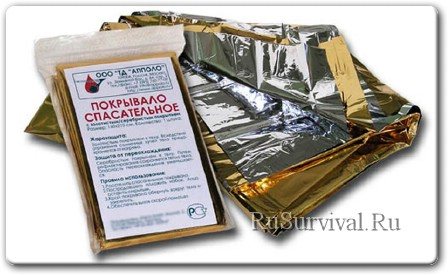
The cheapest thing is to order a rescue blanket from a Chinese online store. Below are links to buy a rescue blanket, choose the one that interests you most.
• A rescue blanket measuring 1 meter x 2 meters secured at the edges is here.
• Gold and silver rescue blanket 1.6 meters x 2.1 meters - here.
• Silver life blanket 1.3 meters x 2.1 meters - here.
• Silver life blanket 1.6 meters x 2.1 meters - here.
Prices for rescue blankets vary slightly, but they are all under $3 including shipping to your post office.
Also worth reading:
Rescue blanket (hypothermic blanket) Mainstay (silver-silver)
There is an informational article about this product on our blog: What is a thermal blanket? There is another informational article about this product on our blog: What is a thermal sleeping bag? The MainStay isothermal blanket is a life-saving thermal blanket for protection against hypothermia or overheating. It is an all-weather, multi-functional space thermal blanket and is ideal for creating an emergency shelter. Another name is a medical isothermal rescue blanket, “survival blanket.” The MainStay thermal blanket is made in the “Blanket” form factor, which translates as “blanket”, “blanket”, or an awning, cape, carpet. Ideal for those cases when, for one reason or another, you were forced to spend the night outside the house or you need protection from wind and cold. Suitable for outdoor picnics, hunting ambushes in the forest and other situations where a waterproof bedding that can protect from cold and dirty ground is required. The secret is simple: the thermal tamper is made of durable polyester film, on which a thin layer of metal foil is applied. Similar material was used by NASA astronauts in the space travel program. It has many useful properties for a traveler: it does not get wet, is not blown out, retains heat on one side and allows it to pass through on the other. Thermal blanket is an invariable attribute of survival equipment for rescuers, firefighters, doctors, and security professionals. When completing paramedic bags or emergency packs, they are included in their composition under the name “Rescue blanket (isothermal)” or “rescue blanket”. Peculiarities:
- Retains up to 90% of your body heat
- Dust, air and moisture proof
- Over 100 different applications
Directions for use:
- Awning, canopy for protection from sun and precipitation
- Water collection container
- Cover hot food for a thermos effect
- Wrap cold beer in it and it will stay cold.
- Is it raining or a bone-chilling wind blowing and you don’t have a raincoat? Now it is !
- As a regular sleeping bag for warm weather and an inner sleeping bag for deadly cold weather
Advantages over conventional sleeping bags:
- Compact packaging (can be carried in your pocket)
- Rescue blanket capable of retaining the heat of the human body and protecting it from external weather influences
- A thin layer of metal applied to the surface of the film turns the film into a flexible mirror that returns heat to the body
Purpose:
- Completing first aid kits
- Professional drivers, motorists, fishermen (especially winter fishing enthusiasts), hunters, tourists, athletes
- Military personnel, special forces employees, prosecutors, rescuers, foresters, rangers
- Providing personal equipment for fans of extreme sports and recreation (especially tourists traveling abroad)
- Just for anyone who often travels on business or moves around the country a lot
Weight: 196 grams Composition: Polyester film with silver coating Dimensions:
- unfolded: 160 x 210 centimeters
- packed: 11 x 9.5 centimeters
Instructions for use : 1. Spread the rescue blanket and straighten it to its full length 2. Place the kit on the victim’s blanket, leaving his face open 3. Wrap the free edge of the blanket around, forming a cocoon around the patient 4. Tuck or secure the edges from unraveling
How to make a knife
— Making knives with your own hands.
School of survival
Tags: "survival gear"
Nikolai
comments:
I agree with the author of the article that a blanket should always be in your backpack if you go outdoors. For example, in my backpack I always have my time-tested golden-silver rescue blanket. It is light, comfortable and can handle any weather.
28.04.2016




